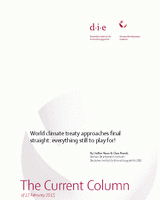World climate treaty approaches final straight: everything still to play for!
Bauer, Steffen / Clara BrandiThe Current Column (2015)
Bonn: German Development Institute / Deutsches Institut für Entwicklungspolitik (DIE) (The Current Column of 17 February 2015)
Bonn, 17 February 2015. Two months after the Lima Climate Change Conference, last Friday saw the signatories to the UN Framework Convention on Climate Change reach agreement in Geneva on a draft text for a new international climate treaty. On the basis of this final document a comprehensive world climate treaty is to be adopted in Paris in December 2015.
The problem is this: the most contentious points were not addressed in Geneva. To make it palatable for everyone, the draft text was repeatedly expanded, eventually reaching almost 100 pages in size and resembling a wish list of options and contradictions.
However, the inclusion of the different positions was important in order to assure all state representatives that their concerns are taken seriously as a subject for negotiation. Nevertheless, the disputed issues are in urgent need of addressing before the treaty is finally signed in Paris, to ensure that it is not a paper tiger from the onset. Five key sticking points here are:
Firstly, legally-binding effect: Many developing and emerging countries oppose the adoption of a legally-binding treaty that commits all states to climate protection goals. However, without the emerging countries it will not be possible to curtail climate change to the extent required. One point of optimism here is the fact that China and the USA could recently bilaterally agree to a joint approach to tackling climate change.
Secondly, mitigation: The Geneva text contains numerous diverging proposals for the designation and monitoring of emission goals for states, as well as the timetable for this. Although it sounds very technical, these issues are essential in order to create a dynamic treaty that enables climate protection goals to also be assessed and improved upon after Paris.
Thirdly, “common but differentiated responsibilities” (CBDR): The different climate policy responsibilities of industrialised and developing countries are still discussed today in accordance with a differentiation dating from 1992. However, since then China has become the biggest emitter of CO2 and a number of developing countries are richer than some industrialised countries. The question is therefore how this rigid division (“firewall”) can be removed or at least shifted and if the CBDR principle can be given a contemporary interpretation. Brazil, for example, advocates a system with more than two groups and Ethiopia proposes retaining the division into two groups but specifying indicators for “graduation” to industrialised country status.
Fourthly, financing: Here, too, the Geneva text contains numerous different options, reflecting highly-varied interests. One thing is certain: without a clear financial perspective for climate protection and adaptation measures in developing countries - an annual figure of USD 100 billion from 2020 is foreseen - there will be no treaty concluded in Paris.
Fifthly, adaptation: With adapting to the consequences of climate change long treated as a subject of secondary importance, the draft Geneva text now raises hopes that these will play a significant role in the Paris treaty. However, the large number of ideas listed does not yet permit a clear focus to be identified: the proposals range from aid payments following weather-related disasters (“Loss & Damage”) to the linking of climate change and human rights. The question of which approaches will prevail in the course of the negotiations and how specific their formulation will be remains an open one.
Ultimately, the decisive issue will be what overall package the negotiators can agree on by December. It is important that an agreement in Paris is not regarded as an end in itself: the relevance of the Paris treaty will depend upon its content. The Geneva text contains every option for an ambitious treaty. To put it bluntly: there is still everything to play for.
The Paris climate conference will be a success if the outcome is a treaty that is firstly ambitious and binding enough to limit climate change to a maximum of 2°C compared to the pre-industrial level, and, secondly, that this is accepted as a fair deal in both ”North” and “South”. Thirdly, this calls for a system that enables the objective monitoring of efforts of individual countries and the regular adaptation of their respective level of ambition.
Whether or not the good mood in Geneva endures will become apparent in June, when negotiations continue in Bonn and states emerge onto the final straight, which should take them through two further rounds of negotiations and a further climate summit of the UN Secretary General in the coming months, culminating in a successful conference in Paris.
This is the time for countries with similar proposals to discuss these with one another in order to employ joint text options in the final conference. The EU in particular can become more involved and should support specific concerns of the developing countries to reinforce alliances beyond the established “North-South” differences, enabling acceleration into the final furlong in Paris.


